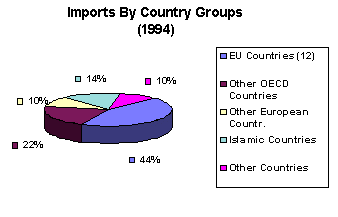Since 1980, Turkish
import regulations have been successively arranged to liberalize
import policy. The basic aims of this policy are:
- Reduction of protectionist measures while seeing that they comply
with the new GATT rules.
- Harmonization of customs tariffs and regulations with the EU for
the Customs Union started at the beginning of 1996,
- Reduction of bureaucratic procedures,
- Securing the supply of raw materials and intermediary goods at
suitable prices within certain quality standards.
Between 1980-93 imports increased
from $7.9 billion US to $29.4 billion US showing an approximately
four-fold increase.
But as a result of the sudden
increase of exchange rates in April 1994 a recession in imports was
observed with a drop of 20.9% compared to the previous year. In 1994
Turkish imports came to $23.2 billion US. In the first ten months of
1995, imports reached $27.8 billion US.
In distribution of imports by sector,
industrial products took the lion's share achieving a 82% share in
1994 with a value of $19.0 billion US. In the mentioned sector a
22.8% drop was seen in comparison with 1993. On the other hand,
mining products took a 12.8% share with a value of US $2.9 billion
in which a 2.4% decrease has been realized. Imports in the
agricultural sector also showed a sharp decrease of 27.5 %. The $1.2
billion US of agricultural imports took a 5.2% share of total
imports.
Among Turkey's imports, raw materials
have always been the majority among all commodity groups. In 1994
raw materials took a 58.4% share of the total imports with a value
of $13.6 billion US . This group is followed by investment goods,
which had a 29.6% share and consumer goods which took a 11.9% share
of the total. In 1994 imports of consumer goods showed a 32.5% drop
from 1993's record level of $4.1 billion US to $2.7 billion US .
Similarly, imports of investment goods decreased to $6.8 billion US
showing a 27.9% change in comparison to 1993.
As for product groups, machines &
mechanical equipment (16.1%) chemicals and chemical products (13.3
%), crude petroleum (10.9 %) iron & steel (8.5 %), electrical
machinery and equipment (7.8 %), textiles and motor vehicles, parts
and accessories are among the major import goods of Turkey.
In 1994, as in past years, the OECD
countries took the lion's share of total imports with a 65.8% share
coming to $15.3 billion US. This group is followed by the Islamic
Countries with a 14.4% share totaling $3.3 billion US.
The European Union accounted for a
44.2% share of total imports with $10.2 billion US. Four of the EU
members are among the top ten suppliers (Germany, Italy, France,
United Kingdom). As on the exports side Germany is the number one
source of Turkish imports.
For the Customs Union Turkey made the
necessary customs reductions. In 1996 Turkey's customs union with
the EU began by abolishing the customs' tariffs between the two
parties and by adopting the common tariff rates for third countries.
Apart from the EU, among other OECD
members the USA with $2.4 billion US is the second most important
source with 10.4% share. Japan with its 4.2% share is another
important supplier.
In the Middle East Saudi Arabia and
Iran retain their importance by entering among the top ten countries
supplying Turkey's imports.
Russia and Ukraine are also important
suppliers to Turkey among the New Independent States. Nevertheless,
some East European, Asian and North African Countries tend to be
alternative suppliers for Turkey.

Source: State Institute of Statistics
|

